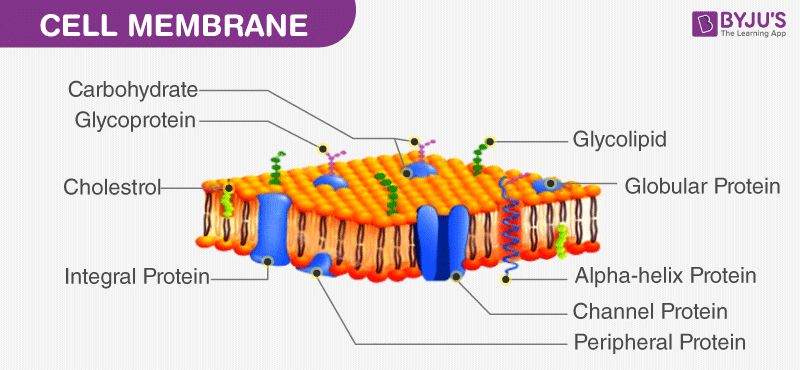The cell from the Latin word cellula meaning small room is the basic structural and functional unit of lifeEvery cell consists of a cytoplasm enclosed within a membrane which contains many biomolecules such as proteins and nucleic acids. For example components of the bacterial cell wall can trigger severe and immediate attacks by neutrophils.

Cell Wall Vs Cell Membrane Quick Differences And Comparison Youtube
In addition to the plasma membrane plant cells have another rigid outer.
. The strands of DNA and protein within the nucleus are called. The Cell Membrane is a Fluid Mosaic. The smallest structure capable of preforming all the functions necessary for life is the ____.
The cell membrane therefore has two key functions. Z describe the general importance of the cell molecules-water mineral ions carbohydrates lipids amino acids proteins nucleotides nucleic acids enzymes vitamins. If the immune system.
This chapter will describe the types of red blood cell antigen and explain why they are so important in medicine today. The cell membrane is semipermeable allowing some substances to pass into the cell and blocking others. Describe how a new cell wall is formed after cytokinesis.
Plants have the wall. Chloroplasts are the key structure in the process of photosynthesis. Cells can acquire specified function and carry out various tasks within the cell such as replication DNA repair protein synthesis and motility.
The contents of a cell are called the protoplasm. Cytoplasm Chloroplasts Cell wall Centrioles 2 See answers Advertisement Advertisement VestaHofman VestaHofman Answer. Cytokinesis is a concluding process to cell division where the parent cell after undergoing the.
A cell is the basic unit of life and all organisms are made up of one or many cells. Structure and Composition of Peptidoglycan. A-Ribosome B-Flagella c- Plasma Membrane D- Cell wall.
One of the things that all cells have in common is a cell membraneIt is. Antigens stimulate an immune response. Based on the observation that not all molecules could enter the cells with the same ease but also aware that the cellulose cell wall could not be involved in the phenomenon he suggested that there was a cell membrane distinct from the cellulose cell wall 1166 and that these cell membranes were made up of ether-soluble components 6768.
Glossary of Animal Cell Terms. The flexibility of the cell membrane also enables the cell to immerse in food and other material from its external environment. Cell Signaling is an important facet of biological life.
The cell membrane functions as a semi-permeable barrier allowing a very few molecules across it while fencing the majority of organically produced chemicals inside the cell. The cell membrane is a. It is where many of the chemical.
Which of the following are functions of the cytoskeleton-Intracellular transport-cell shape-Provide Structural support. Describe the function of each organelle. With the exceptions above members of the domain Bacteria have a cell wall containing a semirigid tight knit molecular complex called peptidoglycan.
A jelly-like material that contains dissolved nutrients and salts and structures called organelles. The cell membrane is flexible and is made up of organic molecules called lipids and proteins. It is present between the cell membrane and the nucleus.
Electron microscopic examinations of cell membranes have led to the development of the lipid bilayer model also referred to as the fluid-mosaic model. In detail Cytokinesis in Plant Cells. Cell structures and their functions.
Peptidoglycan also called murein is a vast polymer consisting of interlocking chains of identical peptidoglycan monomers Figure PageIndex1. If you look at very simple. Cell Membrane The thin layer of protein and fat that surrounds the cell.
Water is the main component of the cytoplasm. To be a barrier keeping the constituents of the cells in and unwanted substancestoxics out. An antigen is any substance to which the immune system can respond.
Cells are covered by a cell membrane and come in many different shapes. Is a semi- fluid substance. Plant cells are easier to identify because they have a protective structure called a cell wall made of cellulose.
Plants also have organelles such as the green chloroplast or large water-filled vacuoles. It allows cells to perceive and respond to the extracellular environment allowing development growth immunity etc. Centrosome Microtubule Organizing Center A small.
Cells are unique to each type of organism. Such processes are known as endocytosis. In this figure The cell membrane defines the inside and outside spaces of a cell.
Z describe the structure and functions of plasma membrane cell wall endoplasmic reticulum ER cilia flagella nucleus ribosomes mitochondria chloroplasts golgi body peroxisome glyoxysome and lysosome. To be a gate allowing the transportation of essential nutrients into the cells and waste products out of the cells. Identify the structure of a typical prokaryotic cell.
Cytoplasm dissolve in it the molecules.

Cell Membrane Structure Function Expii

Cell Wall And Cell Membrane Structure Functions And Differences
Difference Between Cell Membrane And Cell Wall Structure Composition Function
0 Comments